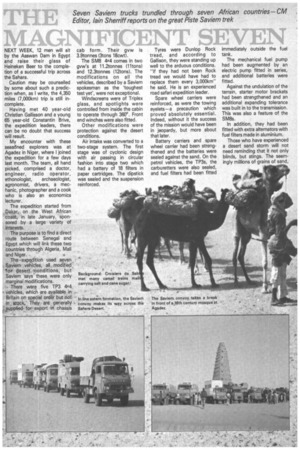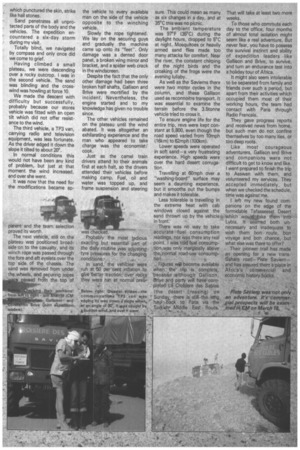NEXT WEEK, 12 men will sit by the Asswan Dam
Page 78

Page 79

If you've noticed an error in this article please click here to report it so we can fix it.
in Egypt and raise their glass of Heineken Beer to the completion of a successful trip across the Sahara.
Caution may be counselled by some about such a prediction when, as I write, the 4,350 miles (7,000km) trip is still incomplete.
Having met 40 year-old Christian Gallisson and a young 65 year-old Constantin Brive, the expedition leaders, there can be no doubt that success will result.
My encounter with these seasoned explorers was at Agadez in Niger, where I joined the expedition for a few days last month. The team, all hand picked, comprised a doctor, engineer, radio operator, ethonologist, archaeologist, agronomist, drivers, a mechanic, photographer and a cook who is also an economics lecturer.
The expedition started from Dakar, on the West African coast, in late January, sponsored by a large variety of interests.
The purpose is to find a direct route between Senegal and Egypt which will link these two countries through Algeria, Mali and Niger.
The expedition used seven Saviem vehicles, all modified for desert ',conditions, but Saviem says these were only marginal modifications.
There were five TP3 4x4 vehicles, which are available in Britain on special order but not in stock, They are generally supped for export in chassis
4:461,11 cab form. Their gvw is 3.9tonnes (3tons 18cwt).
The SM8 4x4 comes in two gvw's at 11.2tonnes (11tons) and 12.3tonnes (12tons). The modifications on all the vehicles, described by a Saviem spokesman as the 'toughest test yet', were not exceptional.
Windscreens were of Triplex glass, and spotlights were controlled from inside the cabin to operate through 360°. Front end winches were also fitted.
Other modifications were protection against the desert conditions.
Air intake was converted to a two-stage system. The first stage was of cyclonic design with air passing in circular fashion into stage two which had a battery of 18 filters in paper cartridges, The dipstick was sealed and the suspension reinforced. Tyres were Dunlop Rock tread, and according to Gallison, they were standing up well to the arduous conditions. "If they had not been Rock tread we would have had to replace them every 3,000km" he said. He is an experienced road safari expedition leader.
Spare wheel carriers were reinforced, as were the towing eyelets—a precaution which proved absolutely essential. Indeed, without it the success of the mission would have been in jeopardy, but more about that later.
Battery carriers and spare wheel carrier had been strengthened and the batteries were sealed against the sand. On the petrol vehicles, the TP3s, the carburetters were also sealed, and fuel filters had been fitted immediately outside the fuel tank.
The mechanical fuel pump had been augmented by an electric pump fitted in series, and additional batteries were fitted.
Against the undulation of the terrain, starter motor brackets had been strengthened and an additional expanding tolerance was built in to the transmission. This was also a feature of the SM8s.
In addition, they had been fitted with extra alternators with fuel filters made in aluminium.
Those who have experienced a desert sand storm will not need reminding that it not only blinds, but stings. The seemingly millions of grains of sand, which punctured the skin, strike like hail stones.
Sand penetrates all unprotected parts of the body and the vehicles. The expedition encountered a six-day storm during my visit.
Totally blind, we navigated by compass and only once did we come to grief.
Having climbed a small plateau, we were descending over a rocky outcrop. I was in the second vehicle. The sand was blinding and the crosswind was howling at force 10.
We made the descent with difficulty but successfully, probably because our stores vehicle was fitted with an open tilt which did not offer resistance to the wind.
The third vehicle, a TP3 van, carrying radio and television equipment, was less fortunate. As the driver edged it down the slope it tilted to about 20°.
In normal conditions this would not have been any kind of problem, but just at that moment the wind increased, and over she went.
It was now that the need for the modifications became ap parent and the team selection proved its worth.
The next vehicle, still on the plateau was positioned broadside on to the casualty, and its winch rope was passed through the fore and aft eyelets over the top side of the chassis. The sand was removed from under the wheels, and securing ropes seed frOm the top of the vehicle to every available man on the side of the vehicle opposite to the winching vehicle.
Slowly the rope tightened. We lay on the securing guys and gradually the machine came up onto its "feet". Only damage was a dented door panel, a broken wing mirror and bracket, and a spider web crack in the windscreen.
Despite the fact that the only other damage had been three broken half shafts, Gallison and Brive were mortified by the incident. Nevertheless, the engine started and to my knowledge has given no trouble since.
The other vehicles remained on the plateau until the wind abated. It was altogether an exhilarating experience and the man who appeared to take charge was the economist/ cook.
Just as the camel train drivers attend to their animals first at each halt, so the drivers attended their vehicles before making camp. Fuel, oil and water was topped up, and frame suspension and steering was chec ed.
Probably the most tedious exacting but essential part of the daily routine was adjusting tyre pressures for the changing conditions.
In sand, the vehicles were run at 50 per cent inflation to give better traction; over rocks they were run at normal ores
sure. This could mean as many as six changes in a day, and at 35°C tnis was no picnic.
The ambient temperature was 97°F (35°C) during the daylight hours, dropped to 5°C at night. Mosquitoes or heavily armed sand flies made too many attacks for comfort. Near the river, the constant chirping of the night birds and the croaking of the frogs were the evening lullaby.
As well as the Saviems there were two motor cycles in the column, and these Gallison used as reconnoitre transport. It was essential to examine the terrain before the 3.5tonne vehicle tried to cross it.
To ensure engine life for the entire trip, revs were kept constant at 5,800, even though the road speed varied from 10mph (16km) to 62mph (100km).
Lower speeds were operated in soft sand—a very frustrating experience. High speeds were over the hard desert corrugation.
Travelling at 60mph over a "washing-board" surface may seem a daunting experience, but it smooths out the bumps and makes it tolerable.
Less tolerable is travelling in the extreme heat with cab windows closed against the sand thrown up by the vehicle in front.
There was no way to take accurate fuel consumption readings, nor was there any real point. I was told fuel consumption was only marginally above the normal road-use consumption.
Figures will become available when the trip is complete, because although Gallison, Brive and party will have completed La Croisiere des Sables (the desert crossing) on Sunday, there is still the long haul back to Paris via the Turkish' Middle East Route, That will take at least two more weeks.
To those who commute each day to the office, four months of almost total isolation might seem like a real adventure. But never fear, you have to possess the survival instinct and ability of expedition leaders like Gallison and Brive, to survive, and turn an endurance test into a holiday tour of Africa.
It might also seem intolerable to be separated from family and friends over such a period, but apart from their activities which occupied them most of their working hours, the team had contact with Paris through Radio Francais.
They gave progress reports and received news from home, but such men do not confine themselves by too many ties, or too deep roots.
Like most courageous adventurers, Gallison and Brive and companions were not difficult to get to know and like. I went prepared to finish the trip to Asswan with them, and volunteered my services. They accepted immediately, but when we checked the schedule, time was against me.
I left my new found companions on the edge of the formidable Tafassesset Desert which wouldjake them into Lybia. It seemed both unnecessary and inadequate to wish them bon route, bon voyage and bon chance, what else was there to offer?
Their pioneer trail has ma an opening for a new tran Sahara road— Piste Savie and has assured them a place Africa's commercial economic history books.


























































































































































